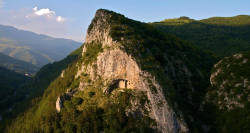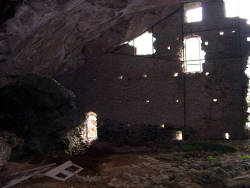Balma del Messere
Grotta dei Saraceni
Useful Information

| Location: |
350 m southeast of Cantarana.
From Albenga at the coast use either SS453, then SS28 to Ponte di Nava, turn right to Cantarana. Or use SS582, SP14, SP216 to Cantarana. (44.1197837, 7.8954581) |
| Open: |
no restrictions. [2021] |
| Fee: |
free. [2021] |
| Classification: |
 Cave House Cave House
|
| Light: | bring torch |
| Dimension: | Ar=200 m². |
| Guided tours: | self guided |
| Photography: | allowed |
| Accessibility: | no |
| Bibliography: |
Giorgio Casanova (1992):
La grotta dei Saraceni a Ormea (Cuneo): tra leggenda e storia,
Antropologia Alpina Annual Report (1990-1). pp 85–114, Torino 1992.
|
| Address: | Balma del Messere, Tel: +39-0, Fax: +39-0, |
| As far as we know this information was accurate when it was published (see years in brackets), but may have changed since then. Please check rates and details directly with the companies in question if you need more recent info. |
|
History
| 10th century | cave fortified. |
| 1979 | excavation by the Institute of Anthropology of the University of Turin. |
| 1982 | excavated by the Archaeological Superintendence of Piedmont. |
Description


The Balma del Messere is a cave house which was created by closing the huge entrance portal of a natural cavern with a wall. The name of the cave is Grotta dei Saraceni (Cave of the Saracens). It is located in the hamlet of Cantarana, in the municipality of Ormea. Its a bit tricky to get there. The normal trail is from Cantarana across the river on SS216, then left on the gravel road, after a few meter right and follow the trail which leads in serpentine across the hill. On the other side in the Prale Canyon the trail to the cave branches off. The main trail continues to Licatti, so it is also possible to start at Licatti and follow the trail into Prale Canyon.
The cave was named Grotta dei Saraceni because of the Saracen raids of the 10th century. The locals believe that the wall was built as a fortification by the Saracens. In 935, they destroyed Castelvecchio and then came to this valley where they stayed for a long time, because it was a good starting point for raids in the rich Piedmontese plain. After a while they converted the natural cave into a Frassineto (fortified place).
The wall is made of local stones held together by a very compact mortar and is 70 cm thick at its foot. The regularity of the wall and the high quality of the mortar are signs of a rather advanced construction technique. There are two small doors at both sides close to the rocky wall. The left door has a double stone arch as a beam, probably intended to better support the weight of the wall. All other openings are high up in the wall, probably a sign of a wooden double floor in the interior. And there is a number of splayed loopholes, which were intended to shoot arrows on enemies. The central part of the wall is collapsed, so it is unknown if there was a central door. Also there are no remains in the interior of the cave, which suggests that the internal structures were made of wood. And finally it is unknown if the cave was actually a fortification or for civil use. There is no archaeological evidence for any possibility.
The cave plays a role in the story of Aleramo del Monferrato. He was the orphan of noble German parents which died on a pilgrimage. He was hired in the imperial army and entered the court of Emperor Otto I, where he met Adelasia or Alasia, daughter of the Emperor. They fell in love, but fearing a refusal to marry, the two lovers fled to the native lands of Aleramo. According to the local version of the legend Aleramo and Adelasia took refuge in this cave. As a result, the name of the cave was changed from Grotta dei Saraceni into Balma del Messere because of those aristocratic guests. However, this detail was not mentioned in the version of the legend reported by the Dominican Jacopo d’Acqui.
- See also
 Search DuckDuckGo for "Balma del Messere"
Search DuckDuckGo for "Balma del Messere" Google Earth Placemark
Google Earth Placemark OpenStreetMap
OpenStreetMap Balma del Messere
Balma del Messere  - Wikipedia (visited: 21-MAR-2021)
- Wikipedia (visited: 21-MAR-2021) La Balma del Messere
La Balma del Messere  (visited: 21-MAR-2021)
(visited: 21-MAR-2021) Balma del Messere (Grotta dei Saraceni) da Prale
Balma del Messere (Grotta dei Saraceni) da Prale  (visited: 21-MAR-2021)
(visited: 21-MAR-2021) Balma Del Messere (grotta Dei Saraceni), Ormea, Cuneo
Balma Del Messere (grotta Dei Saraceni), Ormea, Cuneo  (visited: 21-MAR-2021)
(visited: 21-MAR-2021) Balma del Messere (visited: 21-MAR-2021)
Balma del Messere (visited: 21-MAR-2021)
 Index
Index Topics
Topics Hierarchical
Hierarchical Countries
Countries Maps
Maps